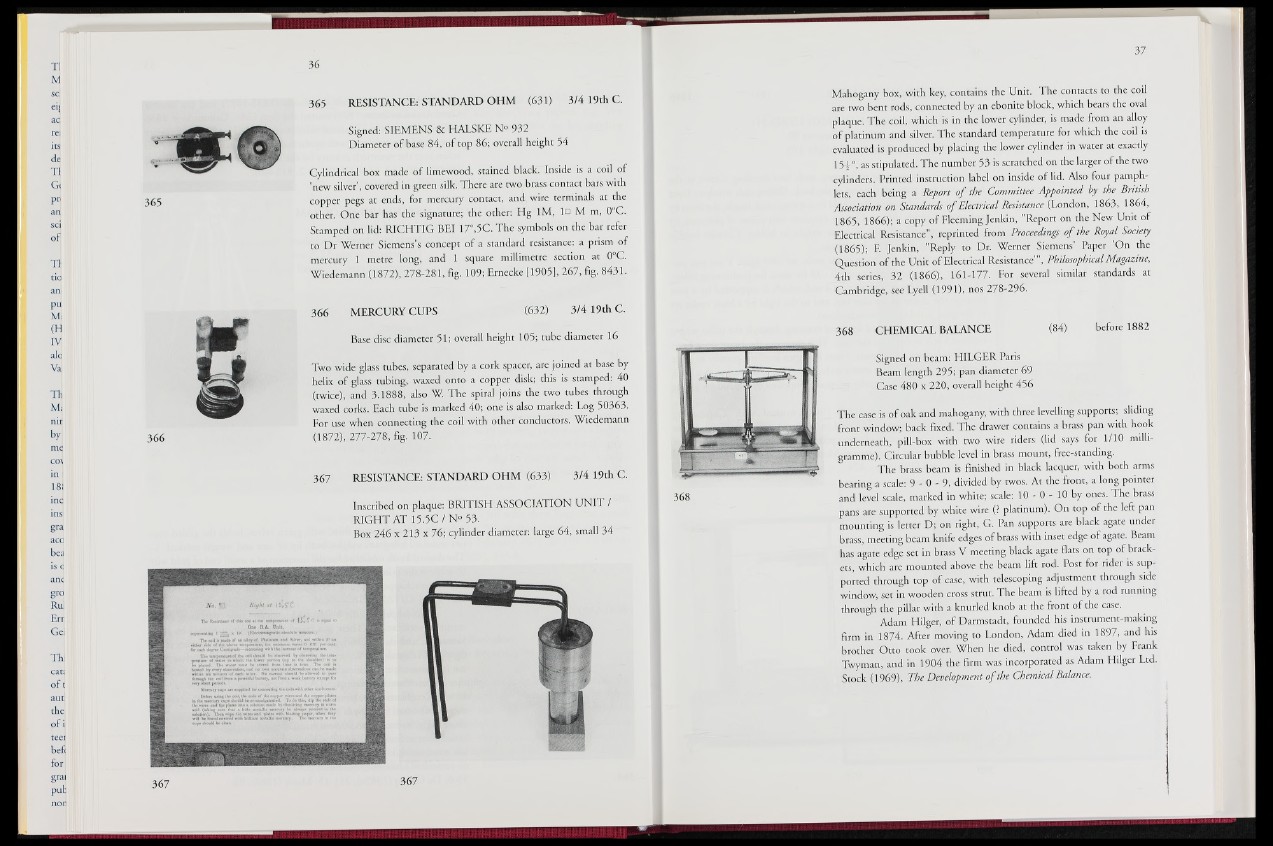
Tl
M sei
eij
ac
rei
its
de
Tl
G<
pn
an
sei
of
Tl
tie
an
pu
M;
(H
IV
ala
Va
Th
Mi
nir
by
me
CCN
in !
181
inc
insi
gra
ac o
bea
is c
anc
gro
Rui
Err
Gei
Th|
cat;
of t
auti
the
ofi
teei
bef<
for
grai
pub
nor
365
365 RESISTANCE: STANDARD OHM (631) 3/4 19th C.
Signed: SIEMENS & HALSKE N° 932
Diameter of base 84, of top 86; overall height 54
Cylindrical box made of limewood, stained black. Inside is a coil of
'new silver', covered in green silk. There are two brass contact bars with
copper pegs at ends, for mercury contact, and wire terminals at the
other. One bar has the signature; the other: Hg 1M, In M m, 0°C.
Stamped on lid: RICHTIG BEI 17°,5C. The symbols on the bar refer
to Dr Werner Siemens's concept of a standard resistance: a prism of
mercury 1 metre long, and 1 square millimetre section at 0°C.
Cl S79.L 278-281. fie. 109: Ernecke F1905], 267, fig. 8431.
366 MERCURY CUPS (632) 3/4 19th C.
366
Base disc diameter 51; overall height 105; tube diameter 16
Two wide glass tubes, separated by a cork spacer, are joined at base by
helix of glass tubing, waxed onto a copper disk; this is stamped: 40
(twice), and 3.1888, also W. The spiral joins the two tubes through
waxed corks. Each tube is marked 40; one is also marked: Log 50363.
For use when connecting the coil with other conductors. Wiedemann
(1872), 277-278, fig. 107.
367 RESISTANCE: STANDARD OHM (633) 3/4 19th C.
Inscribed on plaque: BRITISH ASSOCIATION UNIT / :
RIGHT AT 1 5 .5C /N 0 53.
Box 246 x 213 x 76; cylinder diameter: large 64, small 34
Mahogany box, with key, contains the Unit. The contacts to the coil
are two bent rods, connected by an ebonite block, which bears the oval
plaque. The coil, which is in the lower cylinder, is made from an alloy
of platinum and silver. The standard temperature for which the coil is
evaluated is produced by placing the lower cylinder in water at exactly
15J-°, as stipulated. The number 53 is scratched on the larger of the two
cylinders. Printed instruction label on inside of lid. Also four pamphlets,
each being a Report o f the Committee Appointed by the British
Association on Standards o f Electrical Resistance (London, 1863, 1864,
1865, 1866); a copy of Fleeming Jenkin, "Report on the New Unit of
Electrical Resistance", reprinted from Proceedings o f the Royal Society
(1865); F. Jenkin, "Reply to Dr. Werner Siemens' Paper 'On the
Question of the Unit of Electrical Resistance'", Philosophical Magazine,
4th series, 32 (1866), 161-177. For several similar standards at
Cambridge, see Lyell (1991), nos 278-296.
368 CHEMICAL BALANCE (84) before 1882
Signed on beam: HILGER Paris
Beam length 295; pan diameter 69
Case 480 x 220, overall height 456
The case is of oak and mahogany, with three levelling supports; sliding
front window; back fixed. The drawer contains a brass pan with hook
underneath, pill-box with two wire riders (lid says for 1/10 milligramme).
Circular bubble level in brass mount, free-standing.
The brass beam is finished in black lacquer, with both arms
bearing a scale: 9 - 0 - 9 , divided by twos. At the front, a long pointer
and level scale, marked in white; scale: 10 - 0 - 10 by ones. The brass
pans are supported by white wire (? platinum). On top of the left pan
mounting is letter D; on right, G. Pan supports are black agate under
brass, meeting beam knife edges of brass with inset edge of agate. Beam
has agate edge set in brass V meeting black agate flats on top of brackets,
which are mounted above the beam lift rod. Post for rider is supported
through top of case, with telescoping adjustment through side
window, set in wooden cross strut. The beam is lifted by a rod running
through the pillar with a knurled knob at the front of the case.
Adam Hilger, of Darmstadt, founded his instrument-making
firm in 1874. After moving to London, Adam died in 1897, and his
brother Otto took over. When he died, control was taken by Frank
Twyman, and in 1904 the firm was incorporated as Adam Hilger Ltd.
Stock (1969), The Development o f the Chemical Balance.